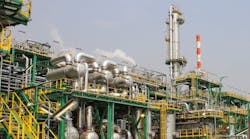The National Petrochemical & Refiners Association normally releases its annual US refining and storage capacity report around mid-July each year. This year’s edition was even timelier than usual.
It arrived as the US House of Representatives prepared to name conferees to meet with those chosen by the Senate to reconcile two different energy bills. One of the biggest differences-okay, one of two 800-lb gorillas in the room (the other being congressional authorization to issue federal oil and gas leases in the Arctic National Wildlife Refuge)-is methyl tertiary butyl ether product-defect liability protection for refiners.
MTBE liability protection is part of the House energy bill but absent from the Senate version. Many observers say it was the main reason Congress failed to pass energy legislation last year. It promises to be a major sticking point in 2005. So NPRA’s report arrived at the right time for policy makers to review domestic refining and storage levels at the beginning of this year, based on the Energy Information Administration’s annual petroleum supply report published in June.
Capacity increase
It showed that, as of Jan. 1, there were 148 operable domestic refineries (excluding those in Puerto Rico and the US Virgin Islands) with 17.1 million b/cd of crude oil distillation capacity. That represented a year-to-year increase of 231,000 b/d, or 1.4%.
NPRA noted that this was the biggest growth since 1999, but still less than the approximately 1.5%/year average increase between 1993 and 2005. US refining capacity growth since 1999 has averaged less than 1%/year, it noted.
Last year’s growth came despite the closure of one refinery representing 5,400 b/d of capacity, according to NPRA. Increases occurred entirely in existing refineries, it noted.
The report listed 495,000 b/d of refining capacity in the Virgin Islands on Jan. 1, unchanged from a year earlier, and 110,000 b/d of capacity in Puerto Rico, down 1,000 b/d year-to-year.
Capacity sold
Four refineries representing 642,000 b/d of domestic refining capacity were sold last year, compared with eight plants representing 552,000 b/d of capacity in 2003, it added. No US refineries were reactivated either year, according to the report.“The number of US refineries continues to decline, with minimal increases in domestic capacity,” noted NPRA Pres. Bob Slaughter. “But we are starting to see more capacity additions, particularly now that we’re clarifying the New Source Review requirements, and also because the economics of the industry have been better the last 2 years.” More than ever, he continued, the US needs an energy policy that balances environmental initiatives involving fuels with energy supply security requirements.
“Unless policies change, future capacity increases will not keep pace with increasing demand for petroleum products. This means that product imports will grow and, perhaps in time, compromise energy security in much the same way that the nation’s dependence on crude imports already does,” Slaughter warned. ✦

